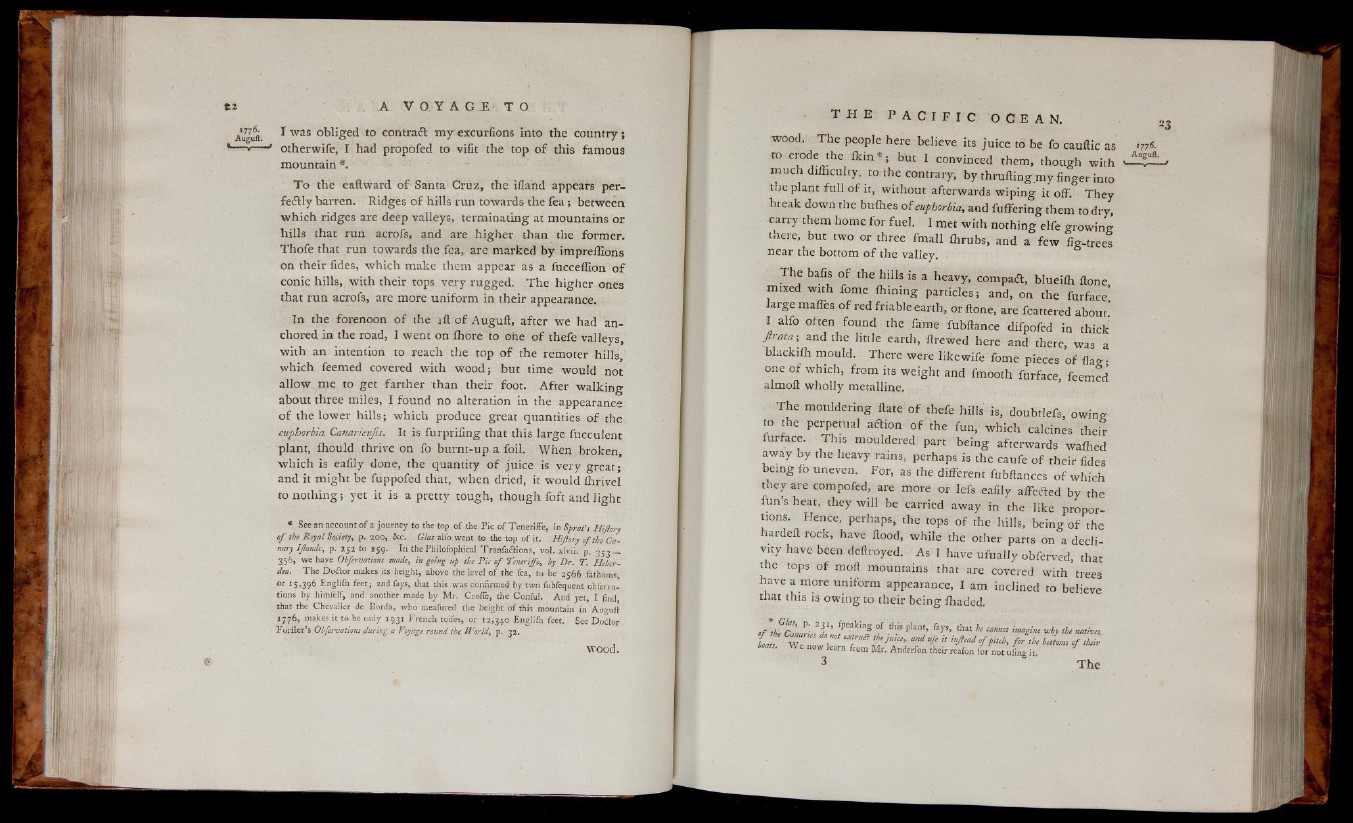
I was obliged to contrail: my excurfions into the country;
otherwife, I had propofed to vifit the top of this famous
mountain *.
To the eaftward of Santa Cruz, the ifland appears perfectly
barren. Ridges of hills run towards the fea; between
which ridges are deep valleys, terminating at mountains or
hills that run acrofs, and are higher than the former.
Thofe that run towards the fea, are marked by impreffions
on their fides, which make them appear as a fucceffion of
conic hills, with their tops very rugged. The higher ones
that run acrofs, are more uniform in their appearance.
In the forenoon o f the i f to f Auguft, after we had anchored
in the road, I went on ffiore to one o f thefe valleys,
with an intention to reach the top o f the remoter hills
which feemed covered with wood; but time would not
allow me to get farther than their foot. After walking
about three miles, I found no alteration in the appearance
o f the lower hills; which produce great quantities of the
euphorbia Canarienfis. It is furprifing that this large fucculent
plant, ihould thrive on fo burnt-up a foil. When broken,
which is eaiily done, the quantity of juice is very great;
and it might be fuppofed that, when dried, it would Ihrivel
to nothing; yet it is a pretty tough, though foft and light
» See an account o f a journey to the top of the Pic of Teneriffe, in Sprat's Hiftory
t f the Royal Society, p. 200, f c . Glas alfo went to the top o f it. : Hiftory o f the Canary
IJIands, p. 252 to 259. In the Philofophical Tranfaaions, vol; xlvii. p. 353 _
356, we have Obfervations made, in going up the Pic o f Teneriffe, by D r. T. Heber-
deu. The DoAor makes its height, above the level o f the fea, to be 2566 fathoms
nr 15.396 Englifh feet, and fays, that this.was confirmed by two fubfequent obferva-
tions by himfelf, and another made by Mr, Crofle, the Conful. And yet, I find
that the Chevalier de Borda, who meafured the height of this mountain in Auguft
1776, makes it to be only 1931 French toifes, or 12,340 Englifli feet. See Doftor
Forfter’s Obfervations during a Voyage round the World, p. 32.
wood.
t h e p a c i f i c o c e a n .
wood. The people here believe its juice to be fo cauftic as
to erode the ik in*; but I convinced them, though with
much difficulty, to the contrary, by thrufting.my finger into
the plant full of it, without afterwards wiping it off. They
break down the bullies of euphorbia, and fuffering them to dry,
carry them home for fuel. I met with nothing elfe growing
there, but two or three fmall ffirubs, and a few fig-trees
near the bottom of the valley. .
The bafis of the hills is a heavy, compart, blueiffi Hone
mixed with fome fluffing particles; and, on the furface’
large maffes of red friable earth, or ftone, are fcattered about!
I alfo often found the fame fubftance difpofed in thick
jirata; and the little earth, flrewed here and there, was a
blackiffi mould. There were likewife fome pieces of flag-
one of which, from its weight and fmooth furface, feemed
almoft wholly metalline.
The mouldering ftate of thefe hills is, doubtlefs, owing
to the perpetual artion o f the fun, which calcines their
furface. This mouldered part being afterwards waffied
away by the heavy rains, perhaps is the caufe of their fides
being fo uneven. For, as the different fubftances of which
they are compofed, are more or lefs eafily afferted by the
fun’s heat, they will be carried away in the like proportions.
Hence, perhaps, the tops of the hills, being of the
hardeftrock, have flood, while the other parts on a declivity
have been deftroyed. As I have ufually obferved, that
the tops of moft mountains that are covered with trees
have a more uniform appearance, I am inclined to believe
that this is owing to their being ihaded.
e / t h f r l’ P'- w fpeakinS ° f W p 'i l i t , fays, thut he cannot imagine why the natives.
m M M i H M H w i " S I X * % boats. W e now learn from Mr, Anderfon their reafon for not uiing it.
3 The
»3